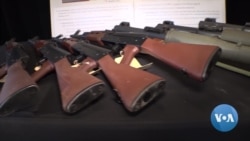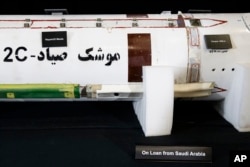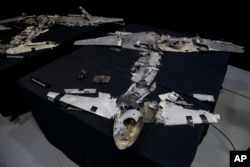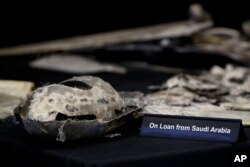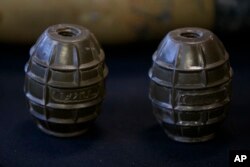The United States is sounding more warnings about Iran’s malign activities across the Middle East and beyond, urging countries to take action or risk growing instability and conflict.
To back up its assertions, the U.S. on Thursday unveiled what it said was more evidence of Tehran’s meddling: pieces of missiles, rockets, drones and other Iranian weaponry, either recovered from Iranian proxies or interdicted on the high seas.
WATCH: US: Iran Floods Unstable Regions With Advanced Weaponry
“The new weapons we are disclosing today illustrate the scale of Iran’s destructive role across the region,” U.S. Special Representative for Iran Brian Hook told reporters while standing in front of a section of a Sayyad-2C surface-to-air missile he said had been intercepted by Saudi forces earlier this year, before it could reach Houthi rebels in Yemen.
“Tehran is intent on increasing the lethality and reach of these weapons to deepen its presence throughout the region,” Hook said. “We are one missile attack away from a regional conflict.”
This is the second time in less than a year that the U.S. has publicly displayed weapons it claims Iran sent to proxies and terrorist groups. Last December, U.S. Ambassador to the United Nations Nikki Haley chastised Iran after showing off parts of missiles and drones recovered by Saudi Arabia and the United Arab Emirates, calling the evidence “undeniable.”
Weaponry
Since then, U.S. officials say the collection has grown to include the surface-to-air missile, long-range drones, anti-tank guided missiles, AK-47s, sniper rifles, grenades and even a second Qiam short-range ballistic missile, also known as a Burkan-2.
U.S. defense officials said the ballistic missile was fired into Saudi Arabia by Houthi rebels in broad daylight Dec. 19, just days after Haley’s rebuke of Iran.
U.S. officials also said Tehran is making little effort to hide the origin of the weapons, even though Iran is prohibited from sending weapons outside the country without approval from the U.N. Security Council.
“The conspicuous Farsi markings are Iran’s way of saying they don’t mind being caught violating U.N. resolutions,” Hook said.
Iranian officials have previously denied U.S. allegations of weapons transfer, deriding the display at a hangar at a U.S. military base in Washington as a fabrication when it was unveiled last year.
Traced to Iran
But U.S. defense officials said all of the weapons in the collection could be traced to Iran in multiple ways, including the presence of Iranian defense company logos, the type of serial numbers ingrained on the weapons, and design features that align perfectly with evidence from photos and videos that Iran itself has made public.
With the drones, officials said all of them used a vertical gyroscope to help with stabilization. They said Iran is the only country in the world known to use vertical gyroscopes.
In the case of a Shark 33 drone, an unmanned boat used by the Houthis to attack Saudi ships, U.S. officials found the GPS component listed 90 locations, two of which were in Tehran. One of those corresponded with the location of the Self Sufficiency Jihad Organization, a research arm of Iran’s Islamic Revolutionary Guard Corps (IRGC).
Images captured on the Shark 33’s computer showed images of a testing facility with an IRGC hat in the background.
While much of the concern focused on Tehran’s support for Yemen’s Houthi rebels, U.S. officials warned that Iranian weapons such as AK-47 machine guns are also finding their way to Shiite militias in Bahrain, while guns and Fadjr rockets had been sent to support the Taliban in Afghanistan.
Officials said there is also evidence Iran is sharing ballistic missile technology with Shiite militias in Iraq.
“It’s not just Saudi and Yemen,” Pentagon spokeswoman Cmdr. Rebecca Rebarich told VOA. “It’s a story of how Iran is proliferating these various weapon systems across the region.”
Training in weapons use
Defense officials contend it is more than just the weapons themselves. Oftentimes, groups getting arms from Iran are getting help, too, from experienced IRGC operators who can help make sure they can use missiles like the Qiam.
“You would have to have an understanding of how to launch one of these,” a defense official said, dismissing the possibility Houthi rebels could operate the missiles without training or guidance.
Some U.S. officials and experts have also argued that Iranian efforts to develop and spread its weapons have only increased since Tehran, the U.S. and other powers initially agreed to the Iran nuclear deal in 2015, using the influx of cash from the deal to expand its reach.
“Iran’s proxy strategy is relatively low cost, but offers the regime a high reward,” Behnam Ben Taleblu, a research fellow with the Foundation for Defense of Democracies, told VOA by email.
“Weapons like anti-tank missiles and rockets may not win conflicts in the Middle East, but can bleed adversaries and force a political solution to the region’s myriad proxy war’s in Iran’s favor,” he added.
Critical time in Congress
The new evidence presented by the U.S. Thursday comes at a critical time. There has been growing concern in Congress about the worsening humanitarian toll as a result of the Saudi-led efforts against the Houthis in Yemen.
U.S. lawmakers and others around the world have likewise been critical of the Saudis for the death of U.S.-based journalist Jamal Khashoggi at the Saudi Consulate in Turkey in October.
“I get Yemen. I understand the strategic relationship between us and Saudi Arabia, but I’m not going to blow past this,” Republican Sen. Lindsey Graham of South Carolina said Wednesday.
No ‘political stunt’
But officials, such as Hook of the State Department, denied the rollout of the new evidence against Iran was designed to help sway support for Saudi Arabia in the face of mounting criticism.
“I haven’t heard anybody say this is a political stunt,” Hook said Thursday. “This is simply putting out in broad daylight Iran’s missiles and small arms and rockets and UAVs and drones.
“Our preference is to use all of the tools that are at our disposal diplomatically,” he added, but warned, “We have been very clear with the Iranian regime that we will not hesitate to use military force when our interests are threatened.”





